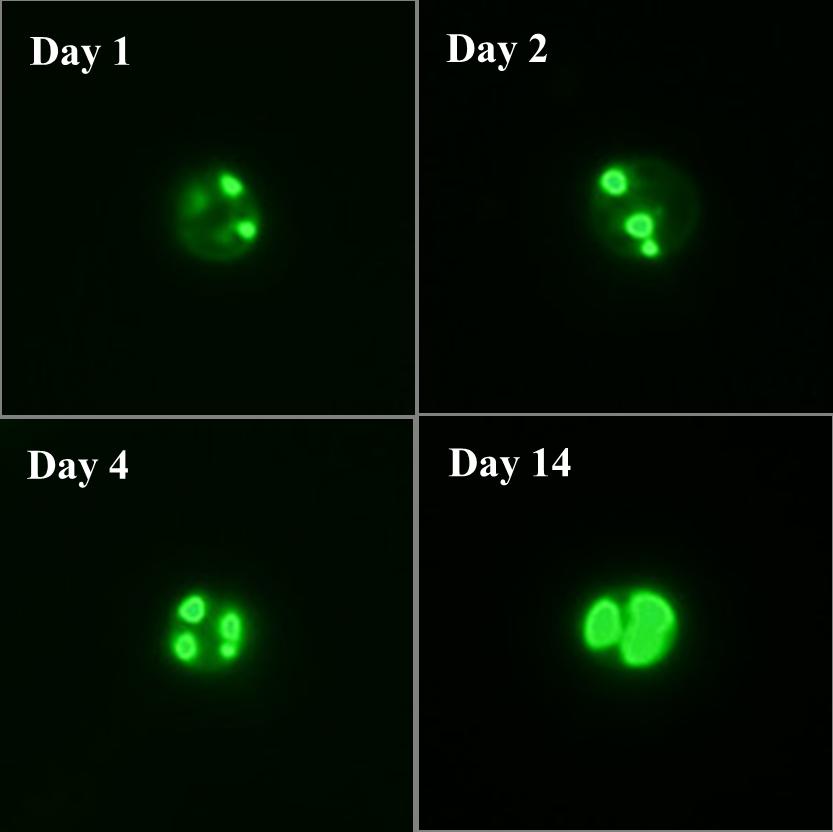青岛能源所在Plant Cell发文揭示分子水平的微藻产油过程动态规律

微拟球藻在缺氮条件下的产油过程。图中均为一个微拟球藻细胞,时间代表开始缺氮诱导后的天数,绿颜色是用Bodipy染料染色的中性脂(其中绝大部分为甘油三酯)。
自然界中的一些微藻因产油量高、生长速度快、环境适应性强,并可在边际土地上用海水或废水培养,被视作一种重要的新型能源作物,但目前对其高产油的代谢和调控机制尚不清楚。近日,中国科学院青岛生物能源与过程研究所单细胞研究中心领导的研究团队率先揭示了分子水平的微藻产油过程动态规律。相关成果于4月1日在线发表于Plant Cell 。
该团队在前期研究中,以微拟球藻为研究模式,揭示了微藻高产油性状的遗传基础和进化规律(Wang, et al, PLoS genetics, 2014)。但是,分子水平上微藻高效合成甘油三酯(即藻油)这一过程究竟是如何发生的呢?该核心问题一直缺乏系统性实验证据的支持。
通过运用高精度的转录组学和脂类组学分析手段,青岛能源所单细胞研究中心博士研究生李敬、王冬梅博士、宁康博士和美国亚利桑那州立大学韩丹翔博士等考察了微拟球藻缺氮诱导产油过程中从3小时到48小时的六个不同时间点下转录组和脂类代谢组的动态变化规律,在国际上率先构建了野生油藻产油过程动态模型。在氮源缺乏时,藻细胞中TAG含量大幅度提高,膜脂含量下降。在转录水平上,糖酵解、PDHC和PDHC旁路、位于线粒体的三羧酸循环和氧化等途径上的相关基因以及特定转运蛋白的转录水平上调,推动碳流由碳水化合物、蛋白及膜脂代谢途径流向甘油酯合成。在TAG组装途径中,位于叶绿体、线粒体和胞质等不同细胞器的7个DGAT基因,在缺氮时转录水平上调,和上游其他上调基因一起,促进大量TAG的合成。该研究阐明的微藻亚细胞水平时间和空间上油脂合成代谢的这一双重调控机制,为高产油藻的基因工程育种提供了重要的理论基础和崭新的研究思路。
这一首个分子水平的微藻产油动态模型还进一步揭示了微拟球藻等野生高产油藻与低产油的莱茵衣藻等在油脂合成全局转录调控方式上的区别。其中,前者具有一型(Type I)脂肪酸合成酶基因,同时其DGAT基因(催化甘油三酯合成的最后一步)转录本的绝对丰度比后者多出两倍。因此前者不仅在DGAT基因的数目(13个)上是目前已知藻类和植物基因组中最多的,而且在缺氮和不缺氮条件下均储备了大量的DGAT转录本,从而高效支撑油脂的大量积累。
该研究获得了基金委重大国际合作项目、科技部“973”和中科院创新团队国际合作伙伴计划等支持,由中科院青岛能源所单细胞研究中心研究员徐健与中科院水生生物所微藻生物技术与生物能源研发中心研究员胡强共同主持完成。
原文摘要:
Choreography of Transcriptomes and Lipidomes of Nannochloropsis Reveals the Mechanisms of Oil Synthesis in Microalgae
Li, J., Han, D., Wang, D., Ning, K., Jia, J., Wei, L., Jing, X., Huang, S., Chen, J., Li, Y., Hu, Q., Xu, J
To reveal the molecular mechanisms of oleaginousness in microalgae, transcriptomic and lipidomic dynamics of the oleaginous microalgaNannochloropsis oceanica IMET1 under nitrogen-replete (N+) and N-depleted (N-) conditions were simultaneously tracked. At the transcript level, enhanced triacylglycerol (TAG) synthesis under N- conditions primarily involved upregulation of seven putative diacylglycerol acyltransferase (DGAT) genes and downregulation of six other DGAT genes, with a simultaneous elevation of the other Kennedy pathway genes. Under N- conditions, despite downregulation of most de novo fatty acid synthesis genes, the pathways that shunt carbon precursors from protein and carbohydrate metabolic pathways into glycerolipid synthesis were stimulated at the transcript level. In particular, the genes involved in supplying carbon precursors and energy for de novo fatty acid synthesis, including those encoding components of the pyruvate dehydrogenase complex (PDHC), glycolysis, and PDHC bypass, and suites of specific transporters, were substantially upregulated under N- conditions, resulting in increased overall TAGproduction. Moreover, genes involved in the citric acid cycle and β-oxidation in mitochondria were greatly enhanced to utilize the carbon skeletons derived from membrane lipids and proteins to produce additional TAG or its precursors. This temporal and spatial regulation model of oil accumulation in microalgae provides a basis for improving our understanding of TAG synthesis in microalgae and will also enable more rational genetic engineering of TAG production.
标签: 甘油三酯 TAG含量
作者:中科院

